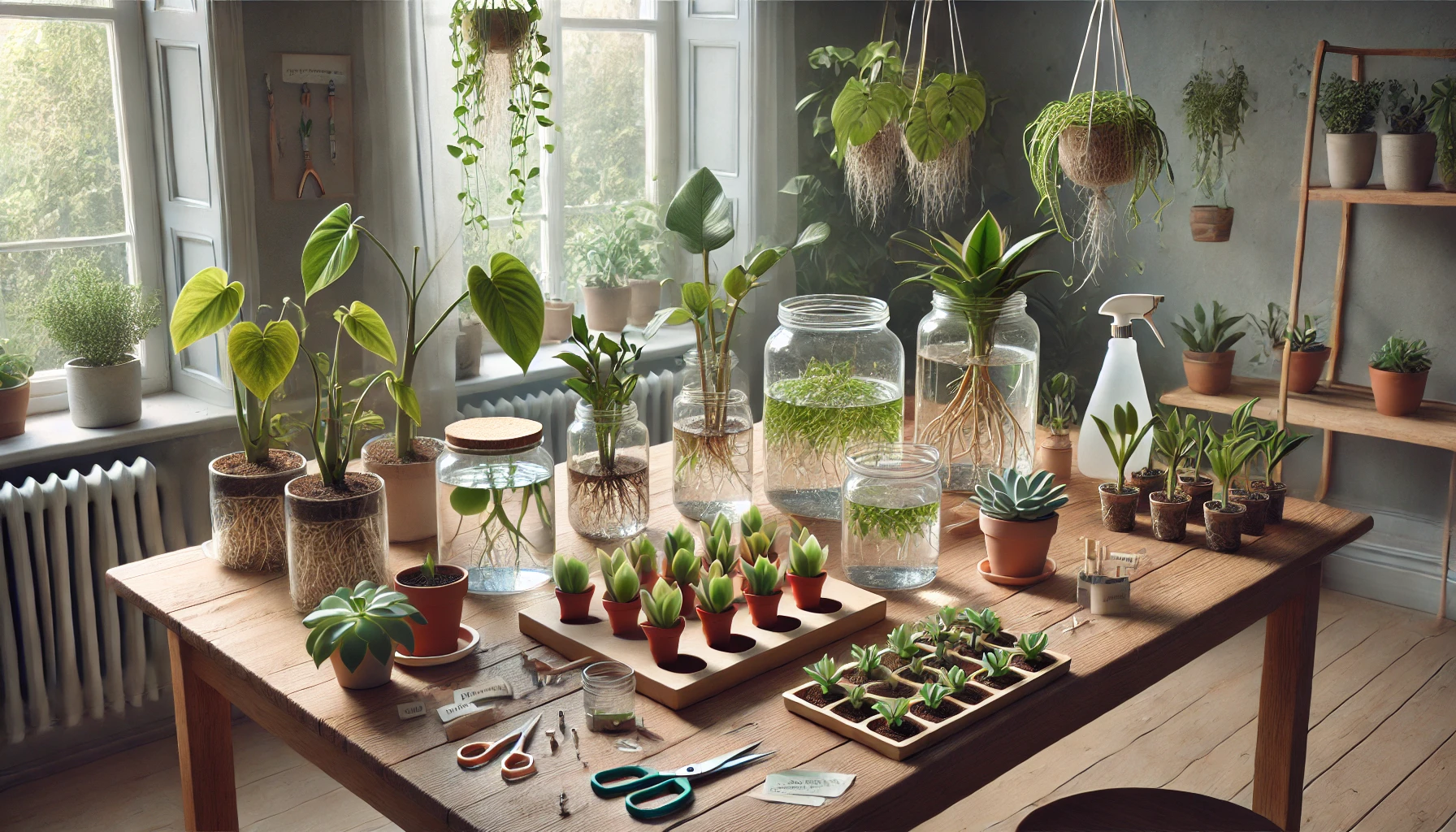There’s something magical about turning one plant into two — or ten. Propagation is the process of creating new plants from existing ones, and it’s not only easy, but also incredibly satisfying. Whether you want to expand your indoor jungle, share with friends, or save money, learning to propagate is a skill every plant lover should have.
In this step-by-step guide, you’ll learn the simplest, most effective ways to propagate houseplants — with tips, tools, and care instructions for each method.
Why Propagate Houseplants?
Propagation isn’t just fun — it’s practical too. Here’s why people love it:
- It’s free
- You can multiply your favorite plants
- Great for making gifts or swaps
- Helps revive a struggling plant
- Encourages bushier, healthier growth on the parent plant
Most importantly, it deepens your connection with your plants and gives you a front-row seat to new growth.
What Plants Are Easy to Propagate?
Not every plant propagates the same way, but some are ideal for beginners. Here are a few top picks:
- Pothos
- Philodendron
- Spider Plant
- Snake Plant
- ZZ Plant
- Succulents (like jade, echeveria, burro’s tail)
- Peace Lily (division)
- Monstera (stem cuttings with nodes)
- Aloe Vera (pups)
Let’s dive into the most common propagation methods.
1. Propagation by Stem Cuttings in Water
Best for: Pothos, philodendron, monstera, tradescantia
How to do it:
- Use clean scissors to snip a 4–6 inch stem just below a node (the bump where leaves and roots grow).
- Remove lower leaves, leaving 1–2 leaves at the top.
- Place the cutting in a clear glass of water, making sure the node is submerged.
- Put the glass in a bright, indirect light spot.
- Change the water every 3–4 days to keep it fresh.
Roots usually appear within 1–3 weeks. Once roots are at least 2–3 inches long, transfer to soil.
2. Propagation by Stem Cuttings in Soil
Best for: Snake plant (leaf cuttings), ZZ plant (stem), rubber plant
How to do it:
- Take a healthy stem or leaf cutting.
- Let the cut end dry and callous for a few hours (especially important for succulents).
- Plant the cutting into moist, well-draining soil.
- Keep in bright, indirect light and mist lightly to maintain humidity.
- Be patient — root development in soil can take longer, but it’s a more direct method.
Use a rooting hormone to speed up the process if desired (optional).
3. Propagation by Division
Best for: Peace lily, ZZ plant, snake plant, aloe vera
How to do it:
- Gently remove the plant from its pot.
- Separate the root ball into smaller sections, ensuring each division has roots and foliage.
- Repot each division into its own container with fresh soil.
- Water lightly and place in a shaded spot for a few days to recover.
This is a fast, reliable method and great for plants that naturally grow in clumps or spread underground.
4. Propagation by Leaf Cuttings
Best for: Succulents like echeveria, jade plant, and burro’s tail
How to do it:
- Gently twist off a healthy leaf at the base — it should come off cleanly.
- Let it dry and callous for 1–3 days.
- Place the leaf on top of dry succulent soil (don’t bury it).
- Mist lightly every few days, keeping the soil barely moist.
- After 1–2 weeks, tiny roots and new rosettes will begin to grow.
Once the new baby plant is established, you can plant it in its own pot.
5. Propagation by Offsets or “Pups”
Best for: Aloe vera, spider plants, haworthia
How to do it:
- Identify a small baby plant (offset) growing from the base of the main plant.
- Gently pull or cut it away with a clean knife, preserving roots if possible.
- Let it air dry for a few hours, especially if it was cut.
- Plant in fresh soil and water lightly.
These “mini-me” plants are the easiest way to grow your collection fast.
Propagation Tools You Might Need
- Clean, sharp scissors or pruning shears
- Glass jars or propagation stations
- Rooting hormone (optional)
- Potting mix (appropriate for your plant type)
- Small pots or nursery containers
- Spray bottle for misting
- Labels to keep track of what’s what
Aftercare Tips for Newly Propagated Plants
Once you’ve propagated, your new plant babies need gentle care:
- Keep them out of direct sun until established
- Mist lightly to maintain humidity
- Avoid fertilizing too soon — wait at least a month
- Don’t overwater; new roots are sensitive
Be patient — propagation is a process, and growth may be slow at first. But with time, roots will strengthen and leaves will multiply.
Troubleshooting Common Issues
Cutting not rooting? Make sure it has a node, enough light, and fresh water or soil.
Mold or rot? Let cuttings dry longer before planting and avoid overwatering.
Yellowing leaves? Might be too much sun, not enough humidity, or poor water quality.
Most problems are fixable — stay observant and adjust as needed.
Final Thoughts: Grow Your Garden, One Cutting at a Time
Plant propagation is a beautiful way to connect with nature on a deeper level. Watching a new plant grow from a tiny piece of another is both empowering and rewarding.
Whether you’re trying it for the first time or already hooked on multiplying your favorites, there’s always something new to learn — and grow.
So grab your scissors, pick your plant, and start your propagation journey today.
